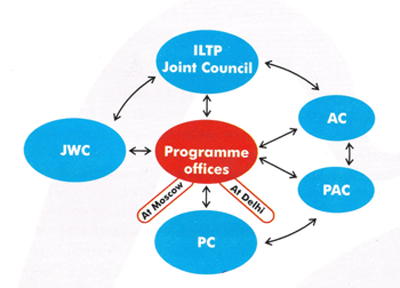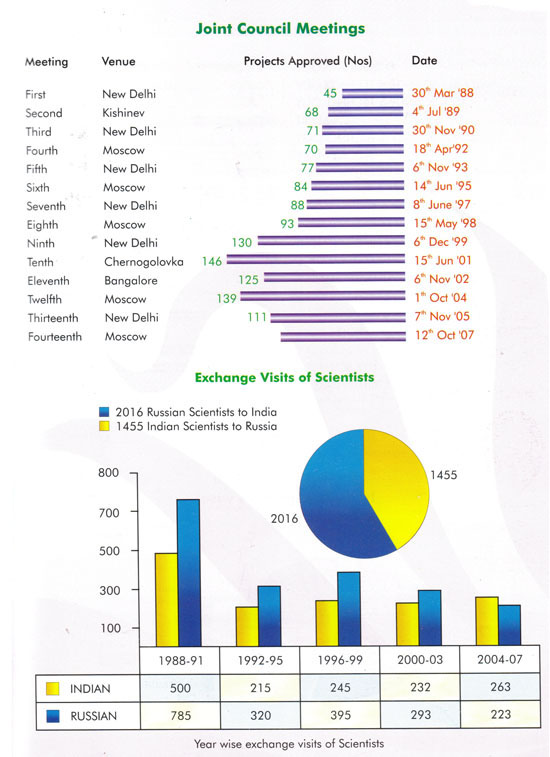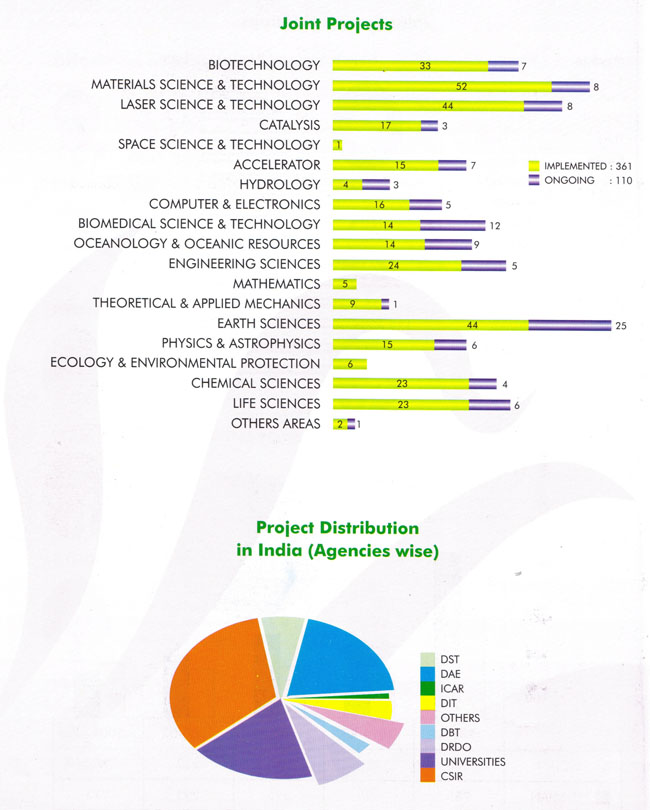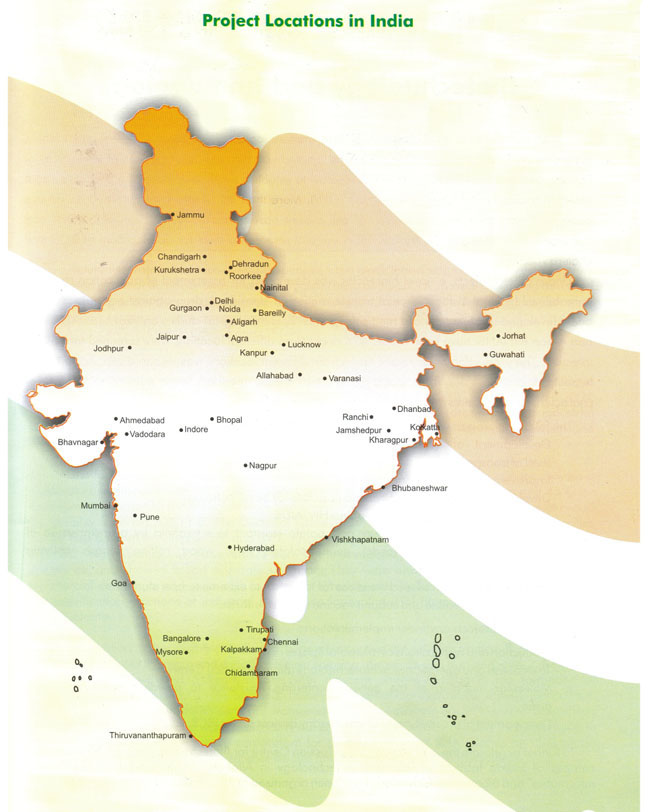
Integrated Long Term Programme of Cooperation (ILTP) in Science & Technology between India and Russian Federation is one of the most exhaustive bilateral collaborative R&D programmes, covering all aspects of science and technology.
Integrated Long Term Programme of Cooperation (ILTP) in Science & Technology between India and Russian Federation is one of the most exhaustive bilateral collaborative R&D programmes, covering all aspects of science and technology. While there is an emphasis on applied research to seek technology transfer, but basic research is also equally important component of the programme. ILTP cooperation agreement was initially signed in Moscow on 3rd July 1987 between India and the former USSR by the then Prime Minister of India and General Secretary of CPSU. Later in the 4th meeting of ILTP Joint Council held at Moscow in April 1 992, the programme was adopted as that between India and Russia.
Considering the benefits which had accrued from the programme and the vast potential available, it was agreed by the two sides to extend the programme by another decade with a focus on technology transfer. An agreement for extension of ILTP up to year 2010, was signed by the then Indian Minister for Science & Technology and Deputy Prime Minister of Russian Federation on 3rd October 2000 in presence of the Prime Minister of India and the President of Russian Federation.
ILTP provides for scientist to scientist and institute to institute interaction in frontier areas of science and technology. Main instrument of cooperation is joint R&D projects of mutual interest which are identified by scientists and are supported by the two sides based on their merit. So far, 361 projects have been implemented and another over 110 are under implementation. Other modes of cooperation include holding of thematic workshops, organizing exploratory visits of senior scientists, fellowships for young Russian scientists and participation in major scientific events on either side.
ILTP is steered by a Joint Council, which is co-chaired by an eminent scientist from either side. From the Indian side Secretaries of scientific departments and other distinguished scientists are members of Council. From the Russian side, President/Vice-Presidents of the Russian Academy of Sciences and Deputy Minister for Education and Science are Members. Cooperation in each identified area is coordinated by a senior scientist from each side who is designated as Area Coordinator.
Thrust Areas |
Basic Science Areas |
|
|
Instruments of Co-operation
|
Current Participation Level |

Joint Council (JC)
Apex body comprising of senior scientists and policy makers from two sides.
Area Coordinators (ACs):
One eminent scientist from each side is nominated for technical coordination in each of the identified areas.
Project Advisory Committees (PACs):
PACs are responsible for assessment, review and monitoring of the project from the Indian side.
Project Coordinators (PCs):
Each project is coordinated by a Project Coordinator from each side. PC is given the overall responsibility for implementation of the projects.
Programme Offices (PO)
Overall coordination of the programme is done by the Programme Offices situated in the DST, New Delhi and RAS, Moscow
1 |
Prof CNR Rao, Linus Pauling Professor and Chairman, Scientific Advisory Council to the Prime Minister, JNCASR, Bangalore |
Co-Chairman |
2 |
Dr. T Ramasami, Secretary, Department of Science & Technology |
Vice Co-Chairma |
3 |
Dr. Anil Kakodkar, Chairman, AEC and Secretary, DAE |
Member |
4 |
Dr. G Madhvan Nair, Chairman, Space Commission and Secretary, DOS |
Member |
5 |
Dr. Mangla Rai, Secreatry, DARE and DG, ICAR |
Member |
6 |
Dr. MK Bhan, Secretary, Department of Biotechnology |
Member |
7 |
Dr. M Natarajan, Secretary, DDRD and SA to RM |
Member |
8 |
Dr. PS Goel, Secretary, Ministry of Earth Sciences |
Member |
9 |
Shri Jainder Singh, Secretary, Department of Information Technology |
Member |
10 |
Secretary, DSIR and DG, CSIR |
Member |
10 |
Dr. NK Ganguli, DG, Indian Council of Medical Research |
Member |
12 |
Dr. RA Mashelkar, President, Indian National Science Academy |
Member |
13 |
Prof S.K. Joshi, Vikram Sarabhai Professor, NPL, New Delhi |
Member |
14 |
Prof V.K. Gaur, Distinguished Scientist, HA, Bangalore |
Member |
15 |
Dr V.C Sahni, Director, RRCAT, Indore |
Member |
16 |
Dr W Selvamurthy, CCR&D (Biomedical Science), DRDO, New Delhi |
Member |
17 |
Shri RC Bhatia, Director General, IMD |
Member |
18 |
Lt. General SS Mehta, Director General, Confederation of Indian Industry |
Member |
19 |
Shri KP Pandian, JS & FA, DST |
Member |
20 |
Shri YP Kumar, Adviser and Programme Coordinator ILTP DST |
Member -Secy. |
|
Co-Chairman |
|
Indian side |
Russian side |
||
BIOTECHNOLOGY & IMMUNOLOGY |
|||
 |
Prof. Vijai Chaudhary, |
 |
Acad. A.l. Grigoriev, |
MATERIALS SCIENCE & TECHNOLOGY |
|||
 |
Prof. SK Joshi, New Delhi |
 |
Acad. F.A. Kuznetsov, |
LASER SCIENCE & TECHNOLOGY |
|||
 |
Dr. VC Sahni, |
 |
Acad. S.N. Bagaev |
CATALYSIS |
|||
 |
Dr. S Sivaram, |
 |
Acad. V.N. Parmon |
|
SPACE SCIENCE & TECHNOLOGY |
|||
Dr. Jacob Ninan, |
Acad. N.S Kardashev, |
||
ACCELERATORS & THEIR APPLICATIONS | |||
 |
Dr. VC Sahni, |
 |
Acad. A.N Skrinsky, |
HYDROLOGY | |||
 |
Dr. KD Sharma, |
 |
Corr-Member |
COMPUTERS & ELECTRONICS | |||
 |
Shri RK Arora, |
 |
Acad. |
BIOMEDICAL SCIENCE & TECHNOLOGY | |||
 |
Dr. W Selvamurthy, |
 |
Acad. A.l.Grigoriev, |
OCEANOLOGY & OCEANIC RESOURCES | |||
 |
Dr. PS Goel, Secretary, Ministry of Earth Sciences, New Delhi |
 |
Acad. O.M Nefedov, |
ENGINEERING SCIENCES | |||
 |
Prof. DV Singh, |
 |
Acad. K.V. Frolov, |
MATHEMATICS | |||
 |
Prof. |
 |
Acad. |
THEORETICAL & APPLIED MECHANICS | |||
 |
Prof. NK Gupta |
 |
Prof. A.V. Manzhirov, |
EARTH SCIENCES | |||
 |
Prof. VK Gaur, |
 |
Acad. A.I. Gliko, |
PHYSICS & ASTROPHYSICS | |||
 |
Prof. Ram Sagar, |
 |
Acad. A.A. Boyarchuk, |
|
ECOLOGY & ENVIRONMENTAL PROTECTION | |||
 |
Dr. Sukumar Devotta, |
 |
Acad. G.S. Gosinlit, |
CHEMICAL SCIENCES | |||
 |
Dr. S Sivaram, |
 |
Acad. O.M. Nefedov, |
LIFE SCIENCES | |||
 |
Dr. SK Brahmachari, |
 |
Acad. A.l. Grigoriev, |



The following projects have been successfully completed:
The following is a list of other projects implemented in the programme :
Under the Project "Study and development of heterogeneous photocatalytic removal of hazardous compounds from water and air " hydroxyapatites of iron, aluminum and lead were preparated and characterized. They were evaluated towards photocatalytic degradation of acetone and orthonitrophenol in a flow circulation reactor at 40°C with a water concentration 4500 ppm. The photocatalytic efficiency were compared with reference to standard titania with a quantum efficiency of 66%. Under the best conditions, iron, zinc and aluminumhydroxyapatite gave less than 5% quantum efficiency
Under the project "Synthesis, characterization and application of a new alumino phosphate based molecular sieves", mesoporous AIPO and SAPO molecular sieves were synthesized at room temperature.
Under the project "Positron and positronium studies" in Chemical physics, positronium formation in liquids have been studied.
Under the project "Synthesis of optically pure non-protienogenic amino acids", ten azalactones, five methyl oxazolones have been prepared. As an extension of this work, L-DOPA (a drug against Parkinsonism) has been prepared.
Study on controlled adsorption of the surfactants and polymers on oxidic mineral systems for encanced benefications of iron ores in their sub-sieve range, studies in development of flotationreagents for processing of complex ores, have been done.
A technology for efficient treatment of waste is resuming into Hydrocarbon Fuel (by burning organic content of the waste is being negotiated. This has a great industrial potential as each city/town has to meet our waste coming out of kitchen or vegetable/fruit markets.
The main achievements of the research work done under the Project "Utilization of silica containing wastes of industries like ash-slag, Zn-PB waste cake, deactivated catalysts etc. for making :alue added products such as frit/glaze materials for ceramic bodies, rare metals, etc," are :
|
153 |
A-4.1 |
METHANE CONVERSION INTO VALUE ADDED CHEMICALS (Implemented) |
|
154 |
A-4.2 |
AMMONIA SYNTHESIS AT MODERATE PRESSURES (Implemented) |
|
155 |
A-4.3 |
ZEOLITE CATALYSIS FOR ORGANIC CHEMICALS PRODUCTION (Implemented) |
|
170 |
A-4.4 |
FISCHER-TROPSCH SYNTHESIS (Implemented) |
|
157 |
A-4.5 |
CATALYTIC POLYMERISATION OF OLEFINE (Implemented) |
|
158 |
A-4.6 |
MATHEMATICAL MODELLING OF CATALYTIC REATORS AND PROCESS DESIGN (Implemented) |
|
159 |
A-4.7 |
INDO-RUSSIAN JOINT VENTURE IN CATALYSIS (Implemented) |
|
160 |
A-4.8 |
OLEFIN HYDROFORMYLATION (Implemented) |
|
161 |
A-4.9 |
CATALYST SYSTEMS FOR PREPARATION OF FURAN BASED PESTICIDES AND DRUG INTERMEDIATES USING SYN-GAS VIA HYDRO FORMATION (Implemented) |
|
162 |
A-4.10 |
CATALYST SYSTEMS FOR SYNTHESIS OF ISOPARAFFINS VIA HYDROGENATION OF ACEYTYLENE IN THE PRESENCE OF CARBON MONOXIDE IN LIQUID PHASE (Implemented) |
|
163 |
A-4.10 |
MOLECULAR STRUCTURE AND REACTIVITY OF MONOLAYER VANADIUM OXIDE CATALYSTS: EFFECT OF MIXED OXIDE SUPPORT (Implemented) |
|
164 |
A-4.12 |
CATALYSIS BY ZEOLITIC SOLID SUPER ACIDS (Implemented) |
|
165 |
A-4.13 |
DEVELOPMENT OF CATALYSTS FOR WAX PRODUCTION BY FISCHER-TROPSCH SYNTHESIS (Implemented) |
|
166 |
A-4.14 |
DESIGN OF BIOFUNCTIONAL SUPPORTED NON-IRON CATALYSTS FOR LOW TEMPERATURE AMMONIA SYNTHESIS. (Implemented |
|
167 |
A-4.15 |
POLYMERIZATION FILLED COMPOSITES AND GAS PHASE POLYMERIZATION BY METALLOCENE CATALYST (Implemented) |
|
168 |
A-4.16 |
STUDY AND DEVELOPMENT OF HETROGENEOUS PHOTOCATALYTIC REMOVAL OF HAZARDOUS COMPOUNDS FROM WATER AND AIR (Ongoing) |
|
169 |
A-4.17 |
DESIGN OF HIGHLY STABLE AND LOW PD CONTAINING CATALYSTS FOR HYDRO DECHLORINATION AND METHANE COMBUSTION: STRUCTURE, REACTIVITY AND REACTION MODELLING (Implemented) |
|
170 |
A-4.18 |
CATALYTIC RE-FORMING OF COAL FOR VALUE-ADDED CHEMICALS (Implemented) |
|
171 |
A-4.19 |
OXIDATION OF HYDROCARBONS BY MOLECULAR OXYGEN AND PEROXIDESSPACE SCIENCE & TECHNOLOGY (Implemented) |


